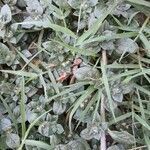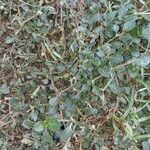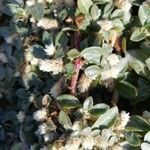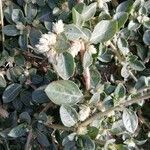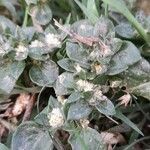Herbs, perennial, 1-5 dm. Stems prostrate to procumbent, villous, glabrate. Leaves sessile; blade rhombic-ovate, oval, or obovate, usually longer than broad, 0.5-2.5 × 0.3-1.5 cm, apex rounded, apiculate, sparsely villous, glabrate. Inflorescences axillary, sessile; heads white to stramineous, ovoid, 0.5-0.8 × 0.4-0.6 cm; bracts shorter than tepals, apex long-attenuate, aristate. Flowers: tepals dimorphic, whitish to stramineous, lanceolate, 3-5 mm, apex acuminate, spinose tipped, densely villous, hairs barbed; stamens 5; pseudostaminodes triangular or subulate, shorter than filaments, margins usually entire, rarely dentate. Utricles included within tepals, brown, ovoid-orbicular, 1.5 mm, apex slightly truncate. Seeds ovate-orbiculate, 1-1.5 mm.
Tepals extremely dissimilar; the outer 2 (abaxial) deltoidlanceolate, 4–4.5 mm., very rigid, 3-nerved below with the laterals meeting the midrib c. two thirds of the way up, midrib excurrent to form an arista less than one quarter the length of the tepal; inner (adaxial) tepal oblong, flat, 3–4 mm., entire or faintly denticulate at the apex, 3-nerved with the laterals meeting the midrib c. two thirds up, finely mucronate; lateral tepals 2.75–3 mm. long, sinuate in lateral view with the two sides connivent above, entire or almost so, sharply mucronate; abaxial and adaxial tepals with glochidiate and barbed whitish hairs to about halfway or more, the laterals with a long tuft in c. the centre half of the midrib.
Inflorescences sessile, axillary, solitary or 2–3 together, usually shortly cylindrical, 0.5–1.5 cm. long and 0.4–0.7 cm. wide; bracts membranous, white or stramineous, 3–3.5 mm. long, deltoid-ovate, glabrous or slightly pilose at the basal margins, distinctly aristate with the excurrent midrib, entire; bracteoles lanceolate, sometimes falcate, commonly somewhat wider on one side of the midrib than the other, 3–3.5 mm. long, glabrous or slightly pilose along the keel, subentire.
Perennial, mat-forming herb. Stems procumbent. Leaves with blade obovate to elliptic, 8-32 x 4-15 mm. Flowers: inflorescence a dense axillary spike; perianth segments very dissimilar in form, segments ± 3 mm long, abaxial segments only shortly aristate, awn < 1/4 of total segment length, ending in sharp point, not so pungent as in A. pungens, white; Jul.-Jun. Fruit orbicular, ± 2 mm long.
Leaves broadly ovate to broadly elliptic or obovate, 0.8–3.2 × 0.4–1.5 cm., rounded to subacute at the apex, sharply mucronate, narrowed below to a distinct petiole up to c. 1 cm. long, glabrous to thinly long-pilose on both surfaces, especially about the base.
Stamens 5, all with anthers, at anthesis subequalling or slightly exceeding the ovary and style, the alternating pseudostaminodes narrowly triangular-subulate, subequalling or slightly shorter than the filaments.
Prostrate herb. Leaves obovate to elliptic. Inflorescence a dense axillary spike. Perianth segments 3 mm long, ending in sharp point but not so pungent as in A. pungens. Flowers white.
Prostrate, mat-forming perennial herb with a stout vertical rootstock, also rooting at the lower nodes, much-branched from the base outwards, mats up to c. 1 m. across.
Stem and branches terete, striate, stout to slender, more or less densely villous with long, white hairs.
Seed discoid, c. 1.25 mm. in diam., brown, shining, faintly reticulate.
Ovary compressed, squat, style very short, about as long as wide.
Fruit orbicular, rounded to retuse above, c. 2 mm. long.
